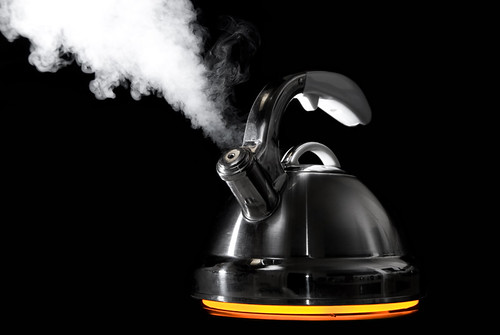It took me just a second to say yes. A tea tasting at Dean & DeLuca hosted by TWG Tea? Of course, I'd go.
After all, I consider myself a tea aficionado. One might say I have more than a little knowledge on the subject. After all, I mail order tea from British importers because I can’t find my favorite brands locally. And I prepare it according to standard tea wisdom—boiling water poured into a warmed crockery pot filled with 2 teaspoons of tea, one for me and one for the pot, which is covered and left to stew for approximately 4 minutes. None of that insipid dunk-and-sip tea for me. I prefer the loose variety, especially black teas—Assam, English Breakfast, and Irish.
I've come a long way from the tea of my childhood—a feeble commercial brand with a bitter aftertaste, which turned as orange as a tropical sunset when the bag sat in the cup for too long. It was medicinal–used to sooth a sore throat—or it was a quaint custom reserved for visits to my Irish granny, who drank tea in a china cup and served cookies on a plate adorned with a paper doily.

In a word, I have evolved—or so I thought until last Thursday afternoon at Dean & DeLuca’s when I sampled TWG specialty teas blended with fragrant flowers, fruit, and spices from around the world. Maranda Barnes, the director and co-founder of TWG Tea, had flown in from Singapore on a mission to educate Americans about this beverage and the need for us to return to Asia to find the best possible teas, harvested from renowned gardens throughout India, China, Sri Lanka and other Asian countries.

Maranda wants to cultivate (so to speak) a new breed of American tea connoisseurs who are eager to enjoy exotic, premium teas at home or in tea salons. To this end, TWG produces over 600 varieties of tea, some blended specifically for the American palate. Their White House Tea, for example, is a white tea infused with roses, fruit and essential oils. It is sophisticated, light and balanced, with a lingering aftertaste of fennel and ripe berries. Another of my favorites is Tea 380, commissioned for Singapore Airlines. It is a blend of white and blue tea (oolong), flavored with flowers, fruit, vanilla and spice.

For me, it was a sensory experience—involving both smell and taste. Different parts of the palate are activated with each sip, something I had experienced when drinking wine. This was no accident. The teas are painstakingly blended to create layers of flavor, which highlight the taste of the tea but don’t overpower it. This in itself was a revelation.
 I’m pleased to report that all the teas I sampled complimented the pastries pictured here. As we sipped and nibbled, we imagined a meal in which each course was paired with a different type of tea. Imagine it. Green, black, white, or oolong teas specially blended to highlight the flavors of each dish.
I’m pleased to report that all the teas I sampled complimented the pastries pictured here. As we sipped and nibbled, we imagined a meal in which each course was paired with a different type of tea. Imagine it. Green, black, white, or oolong teas specially blended to highlight the flavors of each dish. The good news for Maranda and other high-end tea companies is that American tea consumption is steadily rising and so is our interest in specialty teas, according to the Tea Association of the U.S.A. More and more Americans are turning to tea, attracted by its taste, cost, lower levels of caffeine (40 milligrams for a cup of black tea, less than half the amount for coffee), and its healthful benefits. But this is tempered with the Tea Associations' statistics that 85 percent of all our tea is iced and 65 percent of the tea brewed in the United States is prepared using tea bags. And speaking of tea bags, I learned that they contain the “dust” or dregs of the tea leaf.
These two features of American tea consumption have a long history, given that icing tea and putting it into convenient pouches or bags are American inventions dating from 1904. But Maranda reminds me that as Americans we need to reach back to our colonial roots when our ancestors, who were connoisseurs of fine tea, dumped their precious tea into the harbor as a measure of their resentment of British imperialism and the high import tax.
To that, I’d add that American tea drinkers who like the convenience of tea bags don’t have to sacrifice taste or freshness if they simply learn the rating system used by tea growers, which is often printed on tea boxes. The tea is ranked into 4 grades based on 2 criterion: the quality of the crop and the size of the leaf, which is whole, broken or ground. According to Le Palais des Thes, the highest whole leaf category is F.O.P. or flowery orange pekoe, the finest grade composed of the bud of the tea plant and the two leaves nesting around it. Orange doesn’t describe the color of the tea, but comes from the Dutch dynasty Orange Nassau. Pekoe is the Anglicization of the Chinese word “Pak-ho,” meaning “fine hair" or “down.” It refers to the closed bud, which resembles white down. The lowest grade--F. Fannings—is reserved for ground leaves or fannings, also known as dust. This is what typically goes into tea bags.
For those of you who would like to expand your tea horizons and sample TWG, it is currently available through Dean & DeLuca stores in the USA and online at www.deandeluca.com. Over the next few months, they’ll be adding selected classic teas, such as Darjeeling and Earl Grey. Take it from me--Your taste buds will thank you for it.
Additional photos by TWG Tea and the author.


